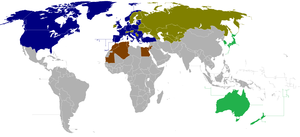Canada–NATO relations
Canada has been a member of the North Atlantic Treaty Organization (NATO) since its inception in 1949.[1] Canada was not only a member but one of the principal initiators (founding countries) of the alliance.[2] This Atlanticist outlook was a marked break with Canada's pre-war isolationism, and was the first peacetime alliance Canada had ever joined. However, Canadian officials such as Hume Wrong and Lester B. Pearson and including Prime Minister Louis St. Laurent worked in favour of the alliance not only because they sought to contain the Soviet Union, as did other members, but because they hoped the treaty would help to eliminate any potential rivalries between the United States, the United Kingdom, and other European great powers (principally at the time France, but later including West Germany), where Canada would be forced to choose sides.[2] This had long been the overriding goal of Canadian foreign policy. The main Canadian contribution to the North Atlantic Treaty was Article 2 which committed members to maintain a "free" political system and to promote economic cooperation, in addition to the more usual diplomatic and military matters.[2] However trans-Atlantic unity in political and economic matters has not come to fruition, as European states have looked toward the European Union and its antecedents while North America has the North American Free Trade Agreement
In terms of military commitments, Canada originally stationed troops in Germany.[3] During the 1950s Canada was one of the largest military spenders in the alliance and one of the few not receiving direct aid from the United States.[4] The costs of maintaining forces in Europe combined with those defending its own vast territory and participation in the Korean War caused strain on the Canadian budget during the 1950s.[5] Despite this Canada was not part of the inner sanctum of large countries that charted NATO policy. Canadian leaders grew disillusioned with the NATO alliance, and began to reduce Canada's commitment. In 1969 then Prime Minister Pierre Trudeau withdrew half of Canada's forces in Europe, even as many leftist intellectuals and peace activists called for a complete withdrawal from NATO.[6] With the success of the Canadian participation in the Suez Crisis, in Cyprus and on other UN peacekeeping missions, perception in Canada was that the forces had shifted from conventional warfighting to peacekeeping missions.[7] Nevertheless, the bulk of Canada's military was focussed on the less-glamorous NATO mission in Germany, where there remained a brigade group and the bulk of an air division. In all, there were over 5,000 soldiers at any given time deployed in Germany until 1993, when the remaining Canadian troops were withdrawn from Europe by the government of Brian Mulroney following the end of the Cold War.[8]
Given the small size of Canada's military, the importance of Canada's contribution to NATO has primarily been political rather than military. However, during the 1999 Kosovo War Canadian CF-18 jets were actively involved in bombing Yugoslavia. Canadian troops were part of the NATO-led mission in Afghanistan, ISAF. In March 2011, the Canadian Forces participated in NATO-led missions in Libya, Angola.
References
- Marco Rimanelli (30 September 2009). The A to Z of NATO and Other International Security Organizations. Scarecrow Press. pp. 144–. ISBN 978-0-8108-6899-1. Retrieved 22 November 2011.
- NATO: When Canada Really Mattered by Norman Hillmer in The Canadian Encyclopedia
- Isabel Campbell, Unlikely Diplomats: The Canadian Brigade in Germany, 1951-64 (2013).
- Rand Dyck (March 2011). Canadian Politics. Cengage Learning. pp. 108–. ISBN 978-0-17-650343-7. Retrieved 22 November 2011.
- John C. Milloy (22 March 2006). The North Atlantic Treaty Organization, 1948-1957: community or alliance?. McGill-Queen's Press - MQUP. pp. 192–. ISBN 978-0-7735-3043-0. Retrieved 22 November 2011.
- Albert Legault; Michel Fortmann (1992). A diplomacy of hope: Canada and disarmament, 1945-1988. McGill-Queen's Press - MQUP. pp. 433–. ISBN 978-0-7735-0955-9. Retrieved 22 November 2011.
- Robert Cameron Orr (2004). Winning the peace: an American strategy for post-conflict reconstruction. CSIS. pp. 49–. ISBN 978-0-89206-444-1. Retrieved 22 November 2011.
- John R. Deni (2007). Alliance management and maintenance: restructuring NATO for the 21st century. Ashgate Publishing, Ltd. pp. 33–. ISBN 978-0-7546-7039-1. Retrieved 22 November 2011.
Further reading
- Bercuson, David J. "Canada, NATO, and Rearmament, 1950-1954: Why Canada Made a Difference (but not for very long)," in John English and Norman Hillmer, eds., Making a Difference: Canada's Foreign Policy in a Changing World Order (Toronto: Lester Publishing, 1992) pp 103–24
- Bercuson, David J. and J.L. Granatstein. Lessons Learned? What Canada Should Learn from Afghanistan (Calgary, 2011).
- Campbell, Isabel. Unlikely Diplomats: The Canadian Brigade in Germany, 1951-64 (University of British Columbia Press, 2013). online review
- Cooper, Andrew F., and Bessma Momani. "The Harper government's messaging in the build-up to the Libyan Intervention: was Canada different than its NATO allies?." Canadian Foreign Policy Journal 20#2 (2014): 176-188.
- Granatstein, J. L. "Is NATO Still Necessary for Canada?." CDFAI policy paper, March (2013). online
- Granatstein, J. L. Canada's Army: Waging War and Keeping the Peace (University of Toronto Press, 2002)
- Kasurak, Peter C. A National Force: The Evolution of Canada's Army, 1950-2000 (University of British Columbia Press, 2013)
- Keating, Thomas F., and Larry Pratt. Canada, NATO, and the bomb: the Western Alliance in crisis (Hurtig Pub, 1988).
- Legault, Albert; Michel Fortmann (1992). A diplomacy of hope: Canada and disarmament, 1945-1988. McGill-Queen's Press - MQUP.
- Maloney, Sean M. War Without Battles: Canada's NATO Brigade in Germany, 1951-1993 (McGraw-Hill Ryerson, 1997).
External links
- NATO: When Canada Really Mattered by Norman Hillmer in The Canadian Encyclopedia
- Canada and NATO by Foreign Affairs Canada

